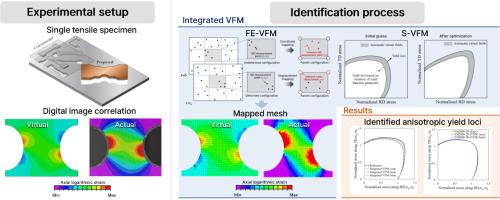Anisotropic plasticity identification: Integrated FE and sensitivity-based virtual fields method
IF 9.4
1区 工程技术
Q1 ENGINEERING, MECHANICAL
International Journal of Mechanical Sciences
Pub Date : 2025-09-08
DOI:10.1016/j.ijmecsci.2025.110815
引用次数: 0
Abstract
An integrated virtual field method (VFM) framework has been developed for the first time by integrating finite element-based VFM (FE-VFM) and sensitivity-based VFM (S-VFM) approaches. This new methodology enhances computational efficiency while maintaining high accuracy in the inverse identification of constitutive model parameters. Full-field displacement measurements are mapped onto finite element meshes to improve data quality and reduce the number of measurement points. Sensitivity-based automatic virtual field generation is incorporated to robustly handle complex anisotropic plasticity models. The proposed approach has been validated using both noise-free virtual experimental data and actual experimental data from SUS316 stainless steel. Results demonstrate that Swift hardening law and quadratic Hill-48 yield function parameters can be accurately identified from a single specimen, achieving significantly reduced computational time compared to conventional VFM. Furthermore, for the first time, the non-quadratic Yld2000–2d anisotropic yield function parameters have been successfully identified using a single specimen with an additional cost function incorporating balanced biaxial tension data. This integrated VFM represents a novel and efficient inverse identification framework, enabling robust determination of complex anisotropic constitutive models with minimal testing.

各向异性塑性识别:综合有限元和基于灵敏度的虚拟场方法
将基于有限元的虚拟场法(FE-VFM)和基于灵敏度的虚拟场法(S-VFM)相结合,首次建立了一个集成的虚拟场法框架。该方法提高了计算效率,同时保持了本构模型参数反演的高精度。为了提高数据质量和减少测点数量,将全场位移测量映射到有限元网格上。采用基于灵敏度的虚拟场自动生成方法对复杂的各向异性塑性模型进行鲁棒化处理。采用无噪声的虚拟实验数据和SUS316不锈钢的实际实验数据对该方法进行了验证。结果表明,该方法可以准确识别单个试样的Swift硬化规律和二次Hill-48屈服函数参数,与传统的VFM相比,显著减少了计算时间。此外,研究人员首次成功地利用包含平衡双轴张力数据的附加成本函数,确定了非二次型Yld2000-2d各向异性屈服函数参数。这种集成的VFM代表了一种新颖有效的反识别框架,能够以最少的测试来稳健地确定复杂的各向异性本构模型。
本文章由计算机程序翻译,如有差异,请以英文原文为准。
求助全文
约1分钟内获得全文
求助全文
来源期刊

International Journal of Mechanical Sciences
工程技术-工程:机械
CiteScore
12.80
自引率
17.80%
发文量
769
审稿时长
19 days
期刊介绍:
The International Journal of Mechanical Sciences (IJMS) serves as a global platform for the publication and dissemination of original research that contributes to a deeper scientific understanding of the fundamental disciplines within mechanical, civil, and material engineering.
The primary focus of IJMS is to showcase innovative and ground-breaking work that utilizes analytical and computational modeling techniques, such as Finite Element Method (FEM), Boundary Element Method (BEM), and mesh-free methods, among others. These modeling methods are applied to diverse fields including rigid-body mechanics (e.g., dynamics, vibration, stability), structural mechanics, metal forming, advanced materials (e.g., metals, composites, cellular, smart) behavior and applications, impact mechanics, strain localization, and other nonlinear effects (e.g., large deflections, plasticity, fracture).
Additionally, IJMS covers the realms of fluid mechanics (both external and internal flows), tribology, thermodynamics, and materials processing. These subjects collectively form the core of the journal's content.
In summary, IJMS provides a prestigious platform for researchers to present their original contributions, shedding light on analytical and computational modeling methods in various areas of mechanical engineering, as well as exploring the behavior and application of advanced materials, fluid mechanics, thermodynamics, and materials processing.
 求助内容:
求助内容: 应助结果提醒方式:
应助结果提醒方式:


